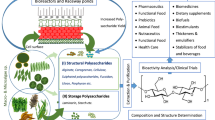Abstract
Two acid phosphatases isolated from culturedIpomoea (moring glory) cells were separated by column chromatography on DEAE-cellulose. The two acid phosphatases have different pH optima (pH 4.8–5.0 and 6.0) and do not require the presence of divalent ions. The enzymes possess high activity toward pyrophosphate,p-nitrophenylphosphate, nucleoside di- and triphosphates, and much less activity toward nucleoside monophosphates and sugar esters. The two phosphatases differ from each other in Michaelis constants, in the degree of inhibition by arsenate, fluoride and phosphate and have quantitative differences of substrate specificity. In addition, they also differ in their response to various ions.
Similar content being viewed by others
References
Cleland WW (1963) The kinetics of enzyme-catalyzed reactions with two or more substrates or products. III. Prediction of initial velocity and inhibition patterns by inspection. Biochem Biophys Acta 67:188–196
Desborough S, Peloquin SJ (1971) Acid phosphatase isozymes in haploids and substrates or products. III. Prediction of initial velocity and inhibition patterns by inspection. Biochem Biophys Acta 67:188–196
Desborough S, Peloquin SJ (1971) Acid phosphatase isozymes in haploids and selfs of groups tuberosum potoato cultivars. Phytochemistry 10:571–572
Dixon M, Webb EC (1964) Enzyme kinetics. In: Enzymes. Toronto: Longmans, Green and Co, pp 62–181
Fiske CH, Subbarrow Y (1925) The colorimetric determination of phosphorus. J Biol Chem 66:375–400
Forte G (1961) Partial purification of a pyrophosphatase from spinach leaves. Biochem Biophys Acta 48:200–202
Forte G, Tognoli C, Parisi B (1962) Purification from pea leaves of a phosphatase that attacks nucleotides. Biochem Biophys Acta 62:251–260
Grover NS, Byrne OR (1975) Genetic control of acid phosphatase isozymes inArabidopsis thaliana (L.). Heyd Biochem Genet 13:527–531
Groves WE, Davis FC Jr, Seals BH (1968) Spectrophotometric determination of microgram quantities of protein without nucleic acid interference. Anal Biochem 22:195–210
Heppel LA, Harkness DR, Hilmoe RJ (1962) A study of the substrate specificity and other properties of alkaline phosphatases ofEscherichia coli. J Biol Chem 237:841–846
Ito E, Kondo S, Watanabe S (1955) Studies of sweet potato phosphatases. I. Specificity. J Biochem (Tokyo) 42:793–803
Joyce BK, Grisolia S (1960) Purification and properties of a nonspecific acid phosphatase from wheat germ. J Biol Chem 235:2278–2281
Krishman PS (1964) Enzymes of phosphate metabolism. In: Linskens HF, Sanwal BD, Tracey MV (eds) Modern methods of plant analysis, vol 7. Berlin: Springer-Verlag, pp 20–66
Lineweaver H, Burk D (1934) The determination of enzyme dissociation constants. J Am Chem Soc 56:658–666
Morin LG, Prox J (1973) New and rapid procedure for serum phosphorus using o-phenylenediamine as reductant. Clin Chim Acta 46:113–117
Newmark MZ, Wenger BS (1960) Preparation and some properties of an acid phosphatase from white lupine seedlings. Arch Biochem Biophys 89:110–117
Roussos GG (1962) Studies on a non-specific acid phosphatase from dwarf-bean seedlings. Biochem Biophys Acta 64:187–189
Shaw JG (1966) Acid phosphatase from tobacco leaves. Arch Biochem Biophys 117:1–9
Shinski H, Kato K (1979) Purification and properties of acid phosphatase from cultured tobacco cells. Phytochemistry 18:243–245
Ueki K, Sata S (1971) Effect of inorganic phosphate on the extracellular acid phosphatase activity of tobacco cells cultured in vitro. Physiol Plant 24:506–511
Veliky IA, Martin SM (1970) A fermentor for plant cell suspension culture. Can J Microbiol 16:223–226
Verjee ZHM (1969) Isolation of three acid phosphatases from wheat germ. Eur J Biochem 9:439–444
Wyen NV, Udvardy J, Farkas GL (1971) Changes in the level of acid phosphatase inAvena leaves in response to cellular injury. Phytochemistry 10:765–770
Zink MW (1980) Acid phosphatases ofIpomoea sp. cultured in vitro. 2. Influence of gibberellic acid on the formation of phosphatases. Can J Bot 58:2171–2180
Zink MW, Veliky IA (1979) Acid phosphatases ofIpomoea sp. cultured in vitro. 1. Influence of pH and inorganic phosphate on the formation of phosphatases. Can J Bot 57:739–753
Author information
Authors and Affiliations
Additional information
Issued as NRCC No. 20658
Rights and permissions
About this article
Cite this article
Zink, M.W., Veliky, I.A. Separation and some properties of two acid phosphatases from suspension cultures ofIpomoea sp.. Plant Cell Tiss Organ Cult 1, 265–273 (1981). https://doi.org/10.1007/BF02318923
Received:
Revised:
Issue Date:
DOI: https://doi.org/10.1007/BF02318923




